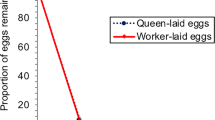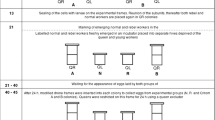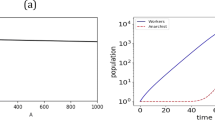Abstract
Using electrophoretic markers, eggs laid by workers were identified in honey bee (Apis mellifera) colonies with a queen. Based on extrapolation, these represented about 7% of the unfertilized (male) eggs laid in the colonies. A very small proportion of workers (of the order of 0.01%) lay these eggs. Worker-laid eggs are rapidly removed, so that very few sons of workers are reared. Thus the reproductive cooperation in bee colonies is maintained by ongoing antagonistic interactions among the members of the colony, with worker laying and egg removal policing by other workers being relatively common.
Similar content being viewed by others
Author information
Authors and Affiliations
Additional information
Received: 24 November 1995/Accepted after revision: 25 May 1996
Rights and permissions
About this article
Cite this article
Visscher, P. Reproductive conflict in honey bees: a stalemate of worker egg-laying and policing. Behav Ecol Sociobiol 39, 237–244 (1996). https://doi.org/10.1007/s002650050286
Issue Date:
DOI: https://doi.org/10.1007/s002650050286




